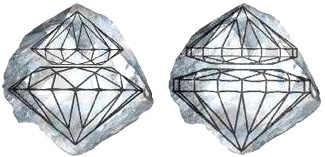Name Brand Diamonds
Hearts & Arrows, Polar Bear, The Leo’s Return of Light, Lazar
Kaplan, Hearts on Fire, Tundra, The Ashoka, Ritani, Sirius,
The Royal Asscher Cut . . .
These are some of the name brand diamonds you’ll come across, and there are more every day. Are these brand names important to the insurer?
A brand name is a shortcut to the buyer’s approval. If the consumer respects the name—or in these advertising-weighted days, hears the name often enough—the name itself will make the sale. That’s the aim, anyway.
But a diamond isn’t a box of cornflakes. Each diamond is valued according to its individual attributes. These attributes, the “4 Cs” of diamonds, are color, clarity, carat weight, and cut. Most important of these is cut.
Cut refers to the geometric proportioning of the diamond. A well cut diamond displays luster and brilliance. Light is reflected and refracted so the gem scintillates. A poorly proportioned stone, on the other hand, can appear lifeless and even dark.
In cutting a diamond to good proportions, about 50% of the weight of the original material is lost. Because consumers value size (carat weight), cutters often sacrifice beauty to save weight. The illustrations below show how cut proportions affect the appearance of the diamond and how much weight is lost in a well cut diamond compared to a poorly cut one.

The left illustration shows two well proportioned gems cut from a diamond rough. At right, the same piece of rough could yield two larger stones (greater carat weight), but they would be poorly proportioned and much less attractive. More detailed information.
Although carat weight is what most consumers look for in a diamond, it is the geometric proportioning of the stone—the diamond’s cut—that accounts for fully half the diamond’s valuation.
So: Does a brand name make a difference?
Some companies do have a reputation for quality. Lazar Kaplan is considered the finest diamond cutter in the world. Sirius is a Canadian firm striving to be the best diamond cutter in Canada. For a buyer interested in quality, these are brands to reckon with.
Some names are merely advertising gimmicks. One Web site calls its diamonds superior to “conventional” diamonds—whatever that means. Another seller touts its diamonds as unique in appearance, but really what it describes is any well-cut diamond. Canadian companies are pushing country of origin. A company executive said: “Swiss watches, Italian leather, French wines. Why not Canadian diamonds?”
Increasingly, these diamonds are coming with fancy certificates attesting to the value of that name, that brand, that store, that country of origin. This is sales promotion. As one wholesaler put it: “If you can put water in a bottle and sell it under a brand name, then trust me, you can brand a diamond. It just takes time.”
The good news for insurers is: You don’t need to know which are the good brands or which are hype. What you do need, whenever you insure a diamond, is a detailed appraisal that includes cut proportions. (Note that most diamond certificates, including GIA’s Diamond Report, do not disclose these necessary details.)
Regardless of brand name, it’s the quality of the diamond itself that sets valuation.
NOTE: Cut is not shape.
Do not be misled by appraisals that give a name as the cut of a diamond, such as Round Brilliant, Oval, Marquise, and so forth. Such terms may also be listed on diamond certificates. These names merely designate the shape of the stone. This is useful information but it says nothing about the quality of the diamond.
Cut should always be given in numbers. (On ACORD 18, 78, 79, 805, cut is described on the line that lists Table Percentage, Crown Angle, Girdle Thickness, etc.) To most insurers the numbers will mean nothing, but to a jeweler they tell precisely how the diamond is cut and they are crucial in setting valuation.
FOR AGENTS & UNDERWRITING
When insuring quality diamond jewelry, require a detailed descriptive appraisal, preferably on ACORD 78/79 prepared by Certified Insurance Appraisers™ (CIA™). A brand name says nothing about the diamond’s worth. A certificate provided by the supplier, cutter or seller is not a substitute for an appraisal.
FOR CLAIMS
Ideally, the appraisal on file will contain a complete description of the piece. If the appraisal is inadequate, brand name information may prove useful, since some companies and sellers are known for their quality. An insurer’s expert working on your behalf can help supply more information about valuation. Above all, do not assume that a brand name automatically justifies a high price, since poorly cut diamonds often masquerade as “branded” diamonds.
NEXT ISSUE
Princess Cut: The Black Sheep of Diamonds
©2000-2025, JCRS Inland Marine Solutions, Inc. All Rights Reserved. www.jcrs.com

